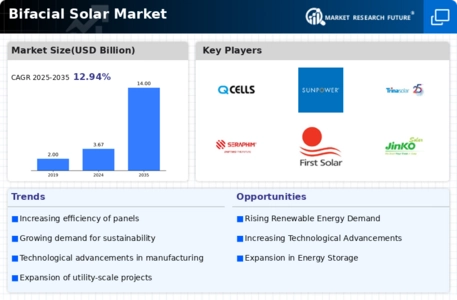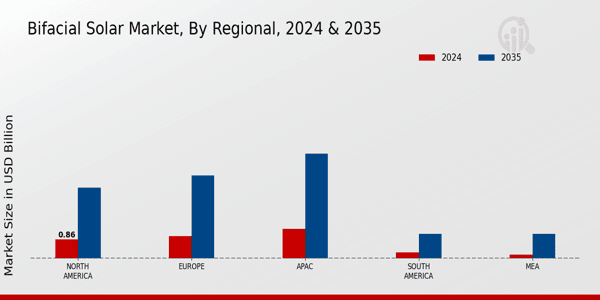Market Growth Projections
The Global Bifacial Solar Market Industry is poised for substantial growth, with projections indicating a market value of 14 USD Billion by 2035. This anticipated expansion is underpinned by various factors, including technological advancements, increasing investments, and supportive government policies. The market is expected to experience a compound annual growth rate (CAGR) of 12.94% from 2025 to 2035, reflecting a robust trajectory for bifacial solar technology adoption. The growth projections highlight the potential for bifacial solar solutions to play a crucial role in the global transition towards sustainable energy systems.
Growing Demand for Renewable Energy
The Global Bifacial Solar Market Industry is experiencing a surge in demand driven by the increasing global emphasis on renewable energy sources. Governments worldwide are implementing policies and incentives to promote clean energy, which is evident in the rising investments in solar technologies. For instance, the market is projected to reach 3.67 USD Billion in 2024, reflecting a robust interest in sustainable energy solutions. This trend is likely to continue as countries strive to meet their carbon reduction targets, thereby enhancing the adoption of bifacial solar panels that offer higher efficiency and energy yield compared to traditional solar technologies.
Environmental Regulations and Policies
The Global Bifacial Solar Market Industry is significantly influenced by stringent environmental regulations and policies aimed at reducing greenhouse gas emissions. Governments are increasingly mandating the adoption of renewable energy technologies, including bifacial solar panels, as part of their climate action plans. These regulations not only create a favorable environment for solar energy adoption but also incentivize investments in cleaner technologies. As nations commit to ambitious climate goals, the demand for bifacial solar solutions is expected to rise, further propelling market growth. This regulatory landscape is likely to shape the future of the solar industry, fostering innovation and sustainability.
Increasing Investment in Solar Infrastructure
Investment in solar infrastructure is a critical driver for the Global Bifacial Solar Market Industry. Governments and private entities are channeling substantial funds into solar projects, which is essential for expanding the deployment of bifacial solar technology. This influx of capital not only supports the installation of solar farms but also facilitates the development of supporting infrastructure, such as energy storage systems. The anticipated compound annual growth rate (CAGR) of 12.94% from 2025 to 2035 indicates a robust investment climate, suggesting that stakeholders recognize the long-term benefits of integrating bifacial solar solutions into their energy portfolios.
Technological Advancements in Solar Technology
Technological innovations play a pivotal role in the Global Bifacial Solar Market Industry, enhancing the efficiency and performance of solar panels. Bifacial solar panels, which capture sunlight from both sides, are becoming increasingly popular due to their ability to generate more electricity. The ongoing research and development efforts are expected to yield improvements in materials and manufacturing processes, potentially reducing costs and increasing energy output. As a result, the market is anticipated to grow significantly, with projections indicating a value of 14 USD Billion by 2035. This growth underscores the importance of technological advancements in driving market expansion.
Rising Energy Costs and Energy Security Concerns
The Global Bifacial Solar Market Industry is also driven by rising energy costs and growing concerns over energy security. As traditional energy sources become more expensive and less reliable, consumers and businesses are increasingly turning to renewable energy solutions. Bifacial solar panels offer a viable alternative, providing a cost-effective means of generating electricity while enhancing energy independence. The shift towards solar energy is not only a response to economic pressures but also a proactive measure to mitigate risks associated with energy supply disruptions. This trend is expected to bolster the market as more stakeholders recognize the value of investing in solar technologies.





















